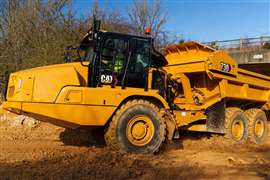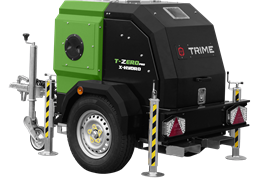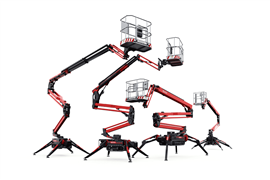New IPAF president looks to the future
19 April 2022
Karin Nars was elected as the new president of IPAF at its AGM in March. Here, Nars shares her view of the Federation and the access industry.
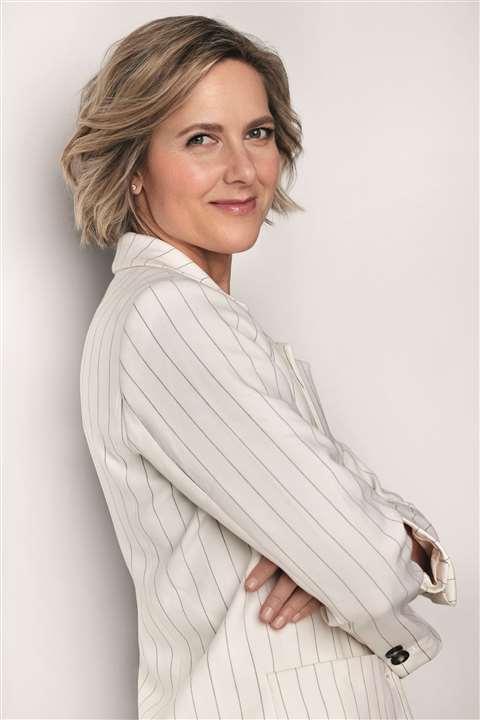 Karin Nars, IPAF President and Dinolift Managing Director. (Photo: IPAF)
Karin Nars, IPAF President and Dinolift Managing Director. (Photo: IPAF)
As the first female president of IPAF, Karin Nars has already made her mark at the helm of the federation’s board.
The depth of experience that Nars brings to the role, along with her vision to make the industry more welcoming to women and enhance IPAF membership in her home region, should also ensure her two-year tenure as president is remembered well into thefuture.
Nars joined the IPAF council in 2010, almost a decade after her father Lasse Godenhielm ended his stint as president in 2001, having joined the federation in the late 1990’s with Dinolift, the Finland-based MEWP manufacturer that he acquired in 1997.
Roll forward to 2022 and Nars now steers Dinolift as its managing director, with one of the company’s goals being international growth beyond its core market of Northern Europe.
The role of an association president
Reflecting on her election to president during IPAF’s Annual General Meeting in March, at which she took over the position from Norty Turner, formally of United Rentals, Nars says, “I’m proud to take on this role and it’s been an honour to work with IPAF over the years.
“Being on the board I have seen how dedicated and passionate the people who work at IPAF are.”
The role of IPAF president is a voluntary one and, as with the rest of the board and wider IPAF council, it serves to oversee and provide support and guidance to the paid executive team, led by its CEO and managing director Peter Douglas.
Nars says, “The president is like an ambassador who is there to contributeto the objectives of IPAF. I’m very much a team player, and there is a really professional team of employees at IPAF that are doing most of the work.“
The council and the board are packed with hundreds of years of fantastic experience; all top notch experts in their field. It’s a really powerful group working for safety in our industry and it’s a brilliant opportunity to take everything we can from that group and spread the word of IPAF.”
How IPAF serves its members
By the end of last year IPAF had surpassed its 1,500 membership milestone, starting 2022 with a record-breaking 1,504 members. “So,we must be doing a lot of things right, and creating value for our members,” comments Nars.
“That is one of the most important things - we are there for our members and we need to be sure that we are delivering the benefits that they are seeking and delivering on our promise to help them achieve safe working at height.”
To confirm this, the federation carried out a membership survey last year, and received encouraging feedback, says Nars, particularly around its online resources, which were deemed to be relevant and extensive.
“We need to keep up that good work. We should always strengthen areas that need improvement but also focus on areas that we are already strong in – strengthen our strengths.”
Last year, there were almost 17,000 downloads of online material from IPAF’s website, such as Toolbox Talks, Andy Access posters and best practice guidance material.
“It is all developed from data from the accident reporting portal. So, it’s a really strong set of resources,” says Nars, adding, “Of course, there are areas where we can do better”.
One area that the federation is focusing on is communication across its member companies.
“There are some parts of the membership that feel they are not so close to IPAF. For example, in certain positions like CEOs or top managers, who don’t see the work that IPAF does in their daily jobs, as it is generally being done in the middle of the organisation.
“All categories of our members need to be aware of what is being done, therefore we need to provide the relevant communication so that the entire company can see the benefit of IPAF.”
Nars adds, “There were also other member categories that had lower rates of engagement and based on those results we have put this in the 2022 plan to rectify those situations.”
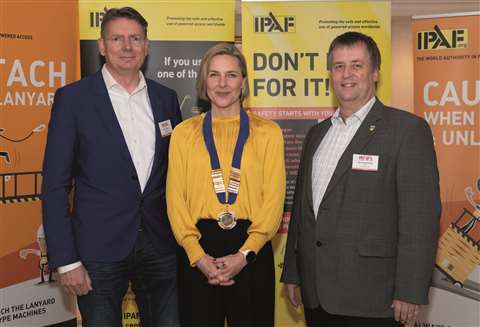 The new IPAF presidential team, from left: JLG’s Karel Huijser, deputy president; Karin Nars, president; and Partnerlift’s Kai Schliephake, vice president.
The new IPAF presidential team, from left: JLG’s Karel Huijser, deputy president; Karin Nars, president; and Partnerlift’s Kai Schliephake, vice president.
Women in the access equipment industry
Beyond the day-to-day process of supporting IPAF’s development programme, Nars aims to use her position to address two personal goals– promoting gender equality in the access industry and developing IPAF in the Nordics.
“I am the first woman to hold this position, therefore it’s an honour and an obligation to promote equal rights for women and opportunities for women in our industry.
“So, I would like to launch a programme around that and use my voice as president to talk about the issue.”
As Nars points out, the level of gender equality is very different across the access industry’s global markets, which makes spreading the message a greater challenge in some parts of the world. “But,” Nars adds, “I want to raise awareness and provide examples of woman who are in leading positions in the industry wherever possible, to highlight the options.”
“Young people, who are choosing their careers are always looking at what role models there are out there and if a young woman only sees a bunch of guys in suits, it does not resonate with them and it creates an extra hurdle.
“It’s a case of highlighting career paths and removing those hurdles.”
Nars provides an illuminating example of the ingrained mindset that can often be found in the industry.
“We are launching a virtual factory tour and we created a 3D computer-generated image of the work that is being done.
“When I watched it for the first time, there were just men in overalls, and I asked, ‘could you add some women,’ as we have a lot of women in our factory.”
“They replied that there were no 3D images available of women wearing overalls. That example is really descriptive of how the industry looks to women.”
Growing association membership levels
The second objective of growing IPAF membership in Nordic countries could be just as challenging. One could be mistaken for believing that Finland and its neighbouring nations have a large IPAF membership thanks to their relatively high level of safety regulations and awareness.
They also have a comparatively large population of MEWPs to other parts of Europe. However, as Nars explains, safety awareness is one of the obstacles.
“There is a strong safety tradition in the Nordic countries and legislation is really strong for worker safety, so maybe there is the idea that they don’t need IPAF.”
Nars adds, “We don’t have any IPAF country councils in Finland or Nordic countries, and I am the first IPAF president from the Nordic countries since my father was president 20 years ago.”
Ukraine ReactionAs a citizen of Finland, which borders Russia, Karin Nars has a unique view of Russia’s invasion of Ukraine. In reaction to the war, Dinolift no longer sells its products or spare parts to Russia or Belarus. “This will of course have an impact on both Dinolift and its customers. But that is a small price to pay compared to the price that the Ukrainian people and the ordinary Russian people are paying. “We hope for peace, but we fear that the situation will get much worse before it gets better.” * See Nars’ further comments on the war in the feature article ‘News Extra: Ukraine’ in the April-May 2022 issue of Access International magazine. |
IPAF does have a representative for the Nordic and Baltic regions, Kent Boström, who Nars says is doing a good job in a challenging environment.
“We are picking up members and in recent years there have been some increases. But there are still very few considering the number of rental companies there, and the number of machines.”
With an IPAF president now back on the ground in Finland, and in close proximity to other Nordic countries, there is now an extra opportunity to reduce that deficit.
“What I see is that IPAF brings third party certification to ensure training is on the same level, and that means construction companies in the Nordic countries can see that someone is trained to a certain level.”
Safety apps for working at height
Beyond these key areas of personal interest, Nars is clear that her role is to support the workings of IPAF.
“We have a really comprehensive three-year plan in place. There is no need for me to bring in a whole new set of objectives.”
There are more than 20 projects that currently contribute to IPAF’s overall strategic aim, with many of them being of a digital nature.
One example is the ePAL app that launched last year in the UK and is now being rolled out globally, as well as being continuously updated, making it an increasingly key tool.
“It’s a really powerful thing which will have a positive impact on a lot of our strategic aims.”
This includes increasing the level of reporting on IPAF’s accident reporting portal, which the federation sees as a vital contributor to a safer industry.
Sharing information about accidents or near misses will become that much easier with the ePAL app available on a mobile phone.
“We have seen in IPAF’s Global Safety Report that understanding more about near misses is really important in avoiding serious incidents. Humans need to have easy access to report accidents and near misses, and when you have that capability on your phone that makes it very simple and fast.”
How IPAF navigated the pandemic
IPAF’s revenue was hit hard in 2020 when much of the world went into lockdown when training centres offering IPAF’s range of qualifications, including of course the PAL card, were forced to close as a result of the Covid-19 pandemic.
“2021 started off with a bit of an unstable market situation but then training levels picked up and in the end, we had a very strong year and went over 2019 levels.”
Focusing on the positives, Nars adds, “In every crisis you can find something good. You can learn and focus on the most important things. We came through it and Peter (Douglas) showed incredibly strong leadership, and the board and counsel were very impressed how IPAF navigated through the crisis.”
One of the initiatives during lockdown was to replace physical events with a series of webinars that proved incredibly popular, each having an average of 800 unique viewers.
“It’s been really popular and that’s something we will continue doing as a way of reaching out on an international level.”
It was also vital to keep the communication channels going between IPAF staff and its member companies throughout the pandemic. And, while webinars helped there was also a great deal of virtual communication with existing and new contacts.
Targeting access markets: Asia and North America
On the subject of new members, IPAF continues to target two major global markets, namely Asia and North America.
Asia, with its range of relatively new access markets is very different overall to the maturity of the North American market.
For IPAF, the ability to move in at the beginning of Asia’s emerging access markets has been a major advantage, compared with North America, the world’s oldest access market, which has a range of long-established training options in place.
Nars says, “In Asia, we have a lot of different countries with a lot of different maturity levels. As more safety standards are put in place, they will become more homogenised, which then creates more interest towards IPAF.
“We also see there is a huge growth in Asian rental and manufacturers and there will be strong opportunities to grow training. There is still a lot of work to be done.”
Moving on to North America, Nars confirms, “North America is a completely different market with different challenges.
“We still need to increase awareness there. I know that rental companies are aware of us, especially as we have had a row of north American IPAF presidents, but we need to create more awareness among the customer base so there is a push-pull effect, in which rental customers are requesting IPAF training.”
Another real option for IPAF in North America is through closer working with existing training bodies.
“We also support the creation of partnerships. We don’t want to compete by saying, ‘who is the best trainingprovider?’
“Everybody should be the winner when it comes to safe working at height. So, working together to form partnerships to work towards more safety in access, I think, is a good way to work in North America.”
It seems IPAF has much to be proud of, not least its 40th anniversary, which it will celebrate next year. “We are always looking forward but this will be an opportunity to look back to see how far we have come, how many lives have been saved and how many work opportunities have been created over those 40 years.
“It’s a chance to really recognise the workthat has been done.”
STAY CONNECTED



Receive the information you need when you need it through our world-leading magazines, newsletters and daily briefings.
CONNECT WITH THE TEAM









